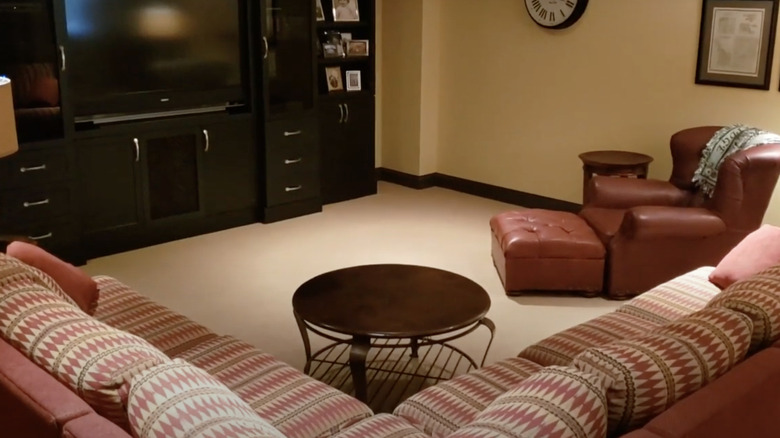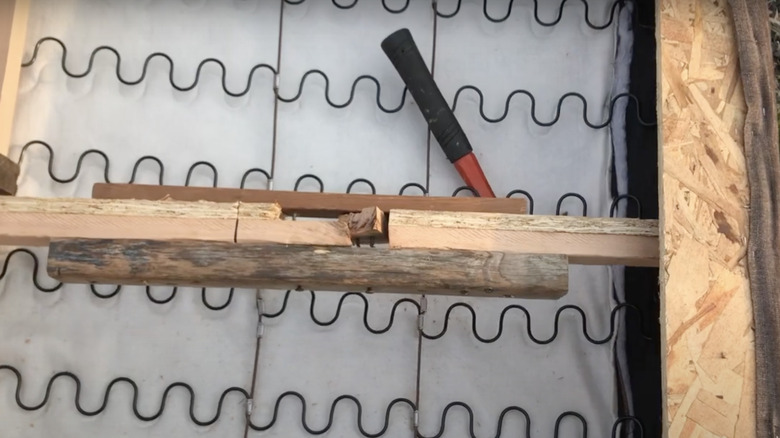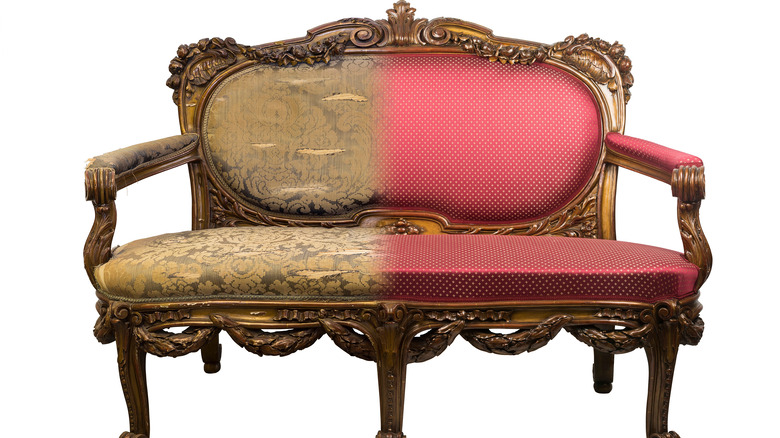5 Signs It's Time To Replace Or Reupholster Your Couch
Over time, your couch becomes something of a family member. Whether for lounging, watching movies, sharing life updates, or taking post-Thanksgiving naps, this furniture piece is useful in countless ways.
But nothing lasts forever. Some people ditch their couches when seeing better, newer options (which is great for resale shops and flea markets), while others hold onto them like the clothes they've long since outgrown. Many often remain part of the family — that is, until the legs, arms, and back fall off and no longer serve a purpose.
Of course, there's got to be a happy medium. Keep your sofa in the living room as long as it's in reasonable shape and you're happy with its performance and appearance. Then again, the lifespan of any ottoman or sectional is finite, even with slipcovers and reupholstering, so don't let them become an eyesore.
McDowell's Repair offers a checklist to determine whether any piece should be repaired or replaced, based primarily on aesthetics and if features no longer work. On average, though, a well-constructed couch should last anywhere from seven to 15 years (via Home of Cozy). Still in need of more information? Here are five reasons to buy a new sofa or reupholster it.
Growing pains
Stop if you've heard this one before: size matters. Nowhere does that ring any more true than when trying to determine what size couch to purchase. A smaller piece will sometimes look like a loveseat in a room that's too big, while a couch that's too large is the furniture equivalent of an 800-pound gorilla squatting in your living room.
And although many English speakers use the terms "couch" and "sofa" interchangeably, there is a difference between them. Sofas, according to Woodstock Furniture & Mattress Outlet, are principally intended for sitting, while couches are meant for lounging and lying down. Since you're able to recline on a couch, sofas can, in fact, also serve as makeshift beds.
Now, ideally, the best time to determine if a couch is too big or small is before making any purchase and after you've measured the living room or wherever else you want it placed, per the Rooms To Go experts. They advise a couch should sit two-thirds lengthwise of a room and two-thirds the size of the wall behind it.
Your couch's height should also be relative to the tallness of your ceilings and not crowd any art. Case in point: A high-backed couch in a room with low ceilings can give off the sensation of living in a doll house. Likewise, if your sofa is too wide, you'll feel like you're riding coach on a budget airline.
Structural support
Experts say if the frame begins to give way, that's a sign your couch needs to be replaced. Like any quality piece of furniture, you should be getting superior lumbar support when sitting. Otherwise, you'll be spending money on muscle relaxers instead of new furniture.
Listen carefully, because there's another "tell" that's just as important: Your couch could be moaning for help. If you hear creaking, that indicates the wood is giving way to overuse or stress. According to Interiors Home, this sound may be audible long before the worst of anything happens and your couch loses a stabilizing piece of its inner anatomy. Should that happen, replace it as soon as possible since things are likely to go south from there — and quickly.
Of course, this can happen gradually, so don't blame yourself before determining whether your couch is the culprit. Still, even the best-made couch will fail eventually. When buying something new, don't sacrifice quality because you could ultimately be spending more money in the long run if you buy a cheap sofa that isn't built to last (via Home Decor Bliss). Structural failure isn't always a fatal blow, but you should ask yourself if any couch is worth saving.
Cushions and pillows
Ready for a little pillow talk? Nothing indicates your couch has reached its expiration date faster than when the pillows no longer provide back support and cushions remind you of a sports car's bucket seats. According to Simplicity Sofas, cushions are the most common replacement part.
Fabrics can also pill, wrinkle, bleach in the sun, or become a magnet for dust and hair, according to Circle Furniture. But that's not the worst possible problem. Your couch could literally stink. That could be because of too many people over the years sleeping and drooling on it. Or, perhaps it's due to errant bits of late-night pizza, pho, fried chicken crumbs, or popcorn kernels getting trapped or embedded. And yes, your pets can surely bring the funk, too.
You should also be mindful of double rubbing, which is the method of measuring the abrasion resistance and durability of a fabric. Put another way, it's how manufacturers describe the number of times people are expected to sit down and get up from the couch (via Toto Fabrics). Since sitting down and getting up constitute a rubbing of the fabric, both motions create a double rub. The most heavy-duty fabrics are said to last for 15,000 double rubs.
Repair time
What's the first thing you notice about a couch? For many people, the overall size comes to mind. Indeed, it's quite likely the largest and most dominant object in your living room. Your couch also tells everyone all kinds of things about you, even beyond your taste in furniture.
Obviously, if your sofa is showing signs of structural fatigue, you'll want to either replace or reupholster it. But here are some questions to consider: Is it worth keeping around? Does it look like someplace you'd sit to listen to Nirvana albums or watch "Arsenio" from? According to Club Furniture, it's not just styling that changes over the years; you change, too.
The good news? You have plenty of options when it comes to rebuilding, reinforcing, and reupholstering your couch practically from splinters. Structural damage underneath (generally caused by too many people sitting or plopping down too hard over time) can even be repaired in a few simple, cost-effective steps, according to Krostrade. Likewise, if you're still in love with the upholstery, you have plenty of options to give it another lease on life, as repair experts can make tears, burns, holes, and cuts disappear.
Making changes
Ultimately, whichever avenue you pursue — replacement or repair — largely depends on questions related to size, style, and budget. If the couch you love is too large or small, there's not a lot you can do about that other than find it a different spot in your home.
But reupholstery can reinvigorate any dated sofa, and additional changes may be possible with help from artisans or woodworkers. The folks at Four Centuries unequivocally state you can change the shape of your couch, too. It will take time and, depending on the changes you request, require complete disassembly and reconstruction. They also warn it's an expensive undertaking and that many pieces get ruined because someone inexperienced decided to take on the DIY project as a money-saver.
Interiors Home has advice on how you can assess whether your couch is ready to re-enlist or ought to be retired: Turn it over and take a look underneath. Are the largest components held together by pins or staples? Pins are by far a safer bet to keep a sofa structurally sound.
Additionally, McDowells is one of many restoration shops doing business across the country. They'll clean, reupholster, and repair scratched or stained wood, as well as freshen up your cushions. There you have it — the pros and cons of refurbishing or replacing your couch entirely. Now, you get to decide which option is best.





